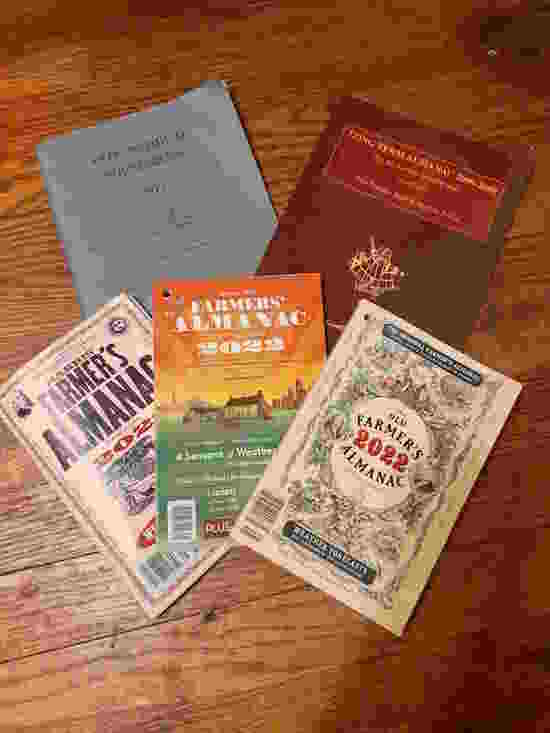
*The Almanac*
By: GVI
30 August 2021
Updated 07 September 2021
The Farmer's Almanac is one of those classic old annuals which everyone talks about but few ever use much. This is a shame, because there's a wealth of useful information in each year's volume. I don't mean the Weather pages. These are so vague as to be useless. Instead, I refer to the astronomy data, which is in fact where the almanac gets its name.
"Almanac" is a word that sounds Arabic but probably isn't. It referred historically to a set of tables full of astronomy information. Nowadays, it can be applied to just about any set of published information, from baseball statistics to the annual "World Almanac Book of Facts" which I've never once looked at but probably should. Perhaps nowadays, the most accurate term for "a list of astronomical data" would be ephemeris; however, no one besides surveyors and occultists use the word (the humor of which is not lost on the author). We're only going to be talking about astronomy in this essay.
A while ago I started an irregular series of articles on "practical primitive astronomy." Starting a project is not the same thing as seeing it through to completion, and this astronomy series is no different. I mean to remedy this deficiency in this article, at least in restarting the series. The almanac is as good a place to begin as any.
You can find almanacs practically anywhere. There are three rather well-known ones - "Farmer's Almanac," "Old Farmer's Almanac" & "Harris' Farmer's Almanac" - as well as several other lesser-known ones. In addition, the U.S. Naval Observatory and the U.K. Hydrological Office jointly publish a Nautical Almanac for each year that costs about $25.00. They also put out a pamphlet called "Astronomical Phenomena" for about $14.00 each year that has the most useful astronomic data for the non-specialist population - these are usually published three years ahead of time, though one year's (2020?) was completely unavailable for reasons I never could figure out. I also happen to own a 50-year almanac put out by a private publisher. Links to purchase each of these will be at the end of the essay, and we'll spend no time on the more obscure ones, such as those whose primary audience is practitioners of occult rituals.
The bulk of this essay will be about the first three, which you can get at any grocery store or drug store. They're the most accessible, they have their information in the most easy-to-understand form, and absolutely the best choice for the non-specialist and non-hobbyist user. Each year's almanac tends to come out by September the year prior, and includes a few months of the old year in its tables.
It's customary in articles like these to make a preparedness case for the item being discussed. Why would we need an almanac in 2021, when our phones can access apps that will tell you where the stars and planets are just by pointing them at the night sky? I've seen such an app and I think it's a miracle of modern technology. I have only the vaguest idea how it works, and this points to why I think an almanac is a handy thing to have.
In a previous article D.I.R.T., I discussed the desirability of being able to do things with different levels of technology, for example microwave/stovetop/campfire. The almanac is in the low-tech region of astronomy - if you want an idea of "no tech" astronomy, think Stonehenge or the shell-and-cord star charts of the Polynesians. The app on our phones - provided we have it - is impressive, but I don't know if such apps continuously update or are continuously supported. Also, phones go dead, often at inconvenient times. So if we need to know astronomy stuff, the almanac is a convenient low-tech supplement to the high-tech phone.
The question which immediately follows is "why would we ever need to know astronomy stuff?" It's a fair question. The "preparedness" answer depends on many things, chief of which is what our particular calamity is and how long it's lasted. If we have no working phone and we need to know where we are (as with a downed aircraft in the Canadian or Alaskan bush), astronomy can help us get within as close as a quarter-mile of where we actually are on the earth, which is usually enough to narrow down to a precise map-spot. If the calamity is longer term, astronomy becomes more practically important. Just drawing one example from memory, many Masonic Lodges were known as "Lunar Lodges," their meeting times being determined by the date of the full moon, which provided the best available light for traveling home. This would become a meaningful concept in a "de-industrial" future, and moonrise/moonset would start to become more important than they are now. Astronomy enables us to calibrate and check our compasses for accuracy with a reliable and independent standard, which I will discuss in an upcoming article. Surveyors had previously used astronomy for reliable direction. I'm probably the last surveyor I know who's actually used "hour-angle" and "altitude" star/sun shots for determining precise direction. It's a skill that's no longer needed but may yet be in a post-industrial future - it's worth preserving. Paragraph 1 of the standard Military Operation Order format lists the rising and setting times of the sun and moon for the period of the operation, for reasons which must certainly be obvious to the reader.
"Practical astronomy" is therefore mostly about navigation but also about time, as our seasons and many religious holidays are determined by the Earth's place in its orbit around the sun and the moon's place in its orbit around Earth. Sorting this out is usually Someone Else's Problem so won't be discussed in any detail. Neither will any further need for practical astronomy - as I'm constantly saying, we prep for the things we can't predict. Knowing a bit of information is often less important than knowing where to find it when you need it.
I have before me the five volumes I introduced a bit ago - the Old Farmer's Almanac, the Farmer's Almanac and the Harris Farmer's Almanac, each for the year 2022, Astronomical Phenomena for the year 2017, and my 50-year almanac. I just bought the first three today - the latter two for the purposes of this essay - and 2022 Astronomical Phenomena is on order at the time of writing. I also have in my library yet another volume on using the moon and the star Kochab to find one's location (called "reducing a lunar") and several books about astronomy for surveying but we're not going to talk about those books at all. I haven't owned a full-sized Nautical Almanac for more than a decade.

The intended audience of the 50-year almanac is navigators - hence the sextant on the cover - though surveyors can make use of the same data for their own purposes. It has instructions on how to perform the calculations to determine one's location using the information in the book and the measurements taken from a sextant. It doesn't go into how to use a sextant, and I presume this is because the author expects the navigator to already know how. It doesn't go into how to use a surveying instrument or compute directions based on astronomic observation either, and I presume this is because the author doesn't realize we can do that. This book, therefore, won't be discussed further because of its limited utility for a general audience - if you don't know how to reduce a "noon fix" or do an "Hour-Angle" method of determining azimuth from the sun or a star, you don't need the 50-year almanac. In fact, the only reason I brought it up at all is because it's called an almanac and therefore readers might accidentally find the link below in a web search, and spend Chili's-dinner-for-two money on it without knowing it's probably not for them.
NOTE: For the purposes of clarity and convenience, I'll be referring to the remaining four books by the following abbreviations:
AP is a sort of "bridge" between the 50-year almanac and the one you can find in the grocery store. It's got information for people with specialized needs (though less than either the 50-year almanac or the huge and expensive Nautical Almanac), but also much for the general-purpose user, and in an almost-easy-to-follow form. Here is a photo of its Table of Contents:
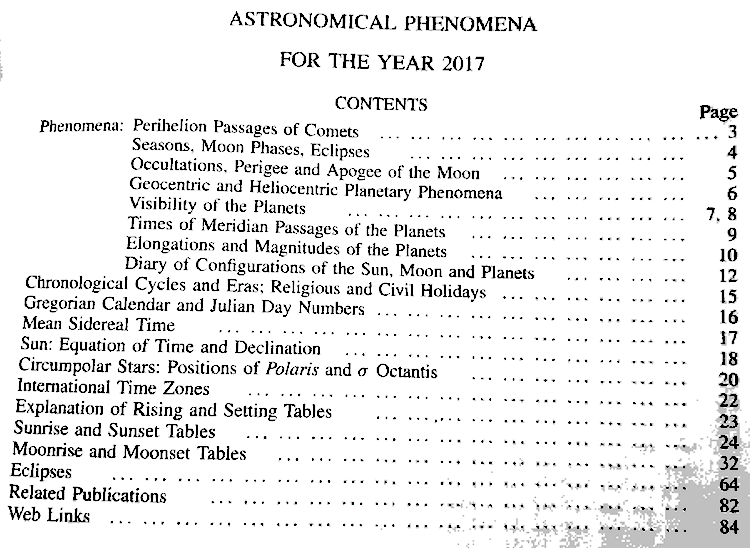
Some of these entries are self-evident as to why someone would want to know them, but others require more explanation. Going item-by item:
For the star-geek, there's a LOT of information in this relatively small (84-page) booklet - your car's owner's manual is much larger. One last thing to say of AP - and it's important - is that all the times listed in it are in GMT or Greenwich Mean Time. This means that while the information in it is beyond reproach, the compilers expect you to do the math to convert GMT to your own local time zone (and your own "local solar time" when necessary).
Lastly, we have the "Farmer's" almanacs. Such annual publications are not an American phenomenon. I've found what are essentially identical publications in the UK, Italy, India, and they must certainly exist elsewhere, though a cursory search doesn't bring any up. Of the major ones in the United States, two things are important to know about them:
The astronomy data for each almanac contains the following:
Each Farmer's Almanac has a word about how to convert the times in their calendar pages to a meaningful degree of local accuracy.
OFA's times are calculated for Boston, MA. In order to find the correction for you, each rise/set time has a "key letter" associated with it. At the back of the book is a table with data for a hundred or so of our largest cities. Consulting this table for the city nearest you, you look up the correction under the corresponding key letter and add or subtract the time.
FA has two different rise/set columns, one for "Northern states" and one for "Southern States." It goes on to discuss how to apply the time correction using a reasonable short-hand for latitude and longitude where you are (you have to know this for yourself).
HFA's instructions to correct their times to your location can best be summed up as "Find someone else reliable putting out the same data; find the algebraic difference between your location and ours for the March Equinox, and apply this algebraic difference across the board." Full marks for radical pragmatism I suppose, but it is rather lazy on their part.
In the interests of FNV, I've calculated the sunrise for Chez GVI using each of the three different almanacs. I used the date of 1 November 2021 because it's the earliest date all three have in common. I compared these results with the results generated by the National Oceanic and Atmospheric Administration (https://gml.noaa.gov/grad/solcalc/sunrise.html). My results are shown in the image below:
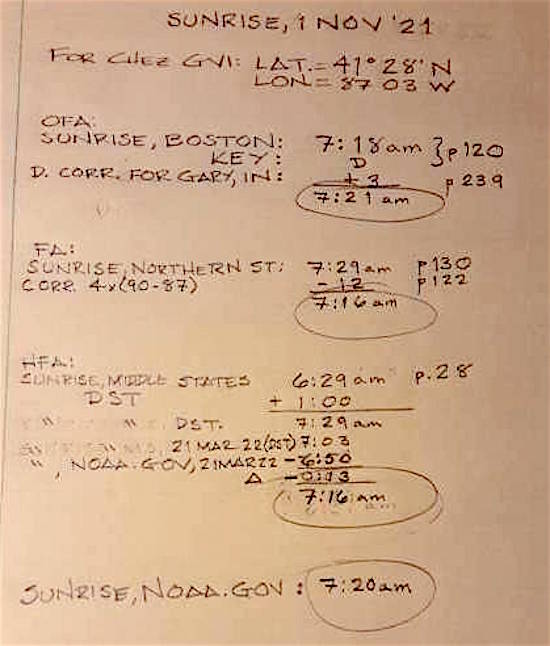
I could have used AP which would have literally been ALL.THE.MATH., but it's late and I reckon Rubie Honor is satisfied with the effort I show above.
What I notice isn't merely that the Old Farmer's Almanac gave the closest result for me and my location; but further, that if I'd taken off the additional one minute to account for the fact that Gary, Indiana is 17 arc-minutes west of me (15 arc-minutes accounts for - rounding off - one minute of time), their result would have matched to the minute.
In fairness to the other two almanacs, I should point out that my results weren't necessarily representative for everyone, but merely an accident of geography. What's more - and you may find this surprising coming from me (which is why I make a point of saying it!) - I think it's unreasonable to demand that rising-and-setting data be more accurate than 5 minutes or so. Atmospherics, local topography, the effect of latitude, the fact that they have to fit everything on one page and keep the methods simple, and how well your watch is set all randomly affect the time you'd first see the upper limb of the sun or moon peek out of the horizon or dip below it.
The truth is I only did these correction calculations to show their relative ease, one system to the next. So long as the results are within about five minutes of a reasonably reliable standard (and I think NOAA meets this standard), the simplicity of the method is the only fair criterion on which to judge the several almanacs. OFA is by far the simplest and returned (in my case) the best result. FA is correct in theory and simple if you know where you are. HFA was just clumsy. Again, I don't hold that four-minute error against the other two publications, or give OFA undeserved credit for being spot-on.
On to the layout, appearance and other subjectives. Each has a different layout, but each is the same every year - these formats don't change, one year to the next. FA puts their weather predictions on the page facing the calendar page - OFA and HFA treat these as separate sections. A photo of each calendar page follows:
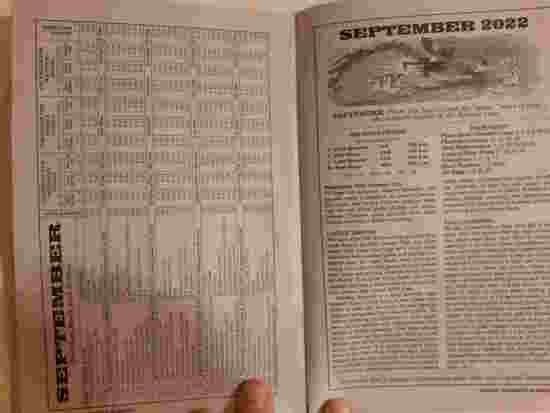
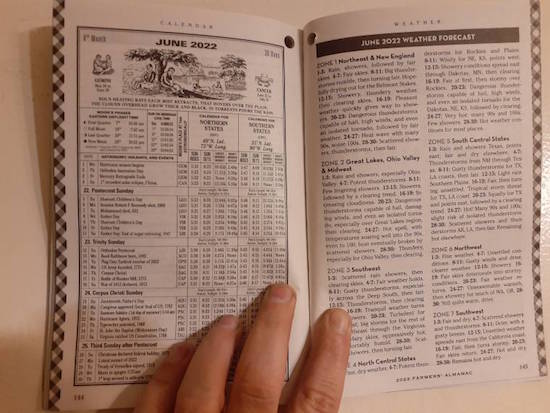
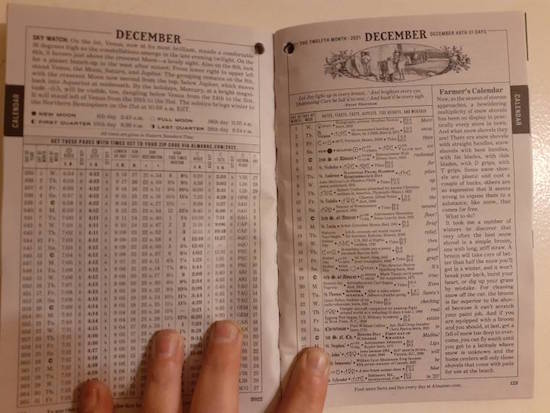
OFA and FA each keep their astronomical data in more-or-less one place, whereas HFA's is scattered throughout. I suppose if HFA were what I'd used over the years I'd be more at ease with the layout, but I find it disorganized. As for binding, OFA and FA have "standard signatures" much like higher-end magazines or cheap books. HFA is stapled.
The rest of the material in the almanacs - the stories, articles, tips, additional data, "interesting" trivia, etc. - is entirely a matter of preference. They are all sufficiently alike in content and character that none of them left a strong enough impression on me to have a meaningful opinion of any of them - trust your own judgment.
We've already discussed the uselessness of the weather predictions. A good article taking them apart can be found HERE. Suffice to say I don't take the almanacs' word for the weather any more than I trust the reliability of the astrologers and psychics in their classified ads. Their astronomy, on the other hand, is reasonably reliable - certainly reliable enough to write into an Army Operation Order.
If you look back through my articles, you'll find where I put up a copy of the Almanac current for the year in my Portable Library. It's a crappy photo, but you can also just make out which almanac I've been buying every year. If you can't make it out, that would be OFA. I only bought the other two tonight for the purposes of this essay, though I'm not unfamiliar with FA.
Back when I worked for a previous employer, I had what must have been the best health care plan on Earth. It wasn't Cadillac - it was BENTLEY. I could have whatever pharmacist I pleased, and the one I chose gave out promotional versions of the FA with your prescription - an ad-free digest with just the calendar, weather and a few other pages. It was the Handiest Thing Ever and I really liked it, especially as at that time I was still in the Reserves and made use of the Almanac as I noted above. That handy little digest was worth its weight.
This essay being my first exposure ever to HFA, I'm not impressed either with its layout or its information. About the only thing I do like about the Harris Farmer's Almanac is the fact that it's entirely newsprint except for the cover, which is cardstock; the other two have glossy magazine pages and cardstock bound in with the newsprint pages.
In the end, of the three "popular" almanacs most easily available, I'd say your choice should be between FA and OFA; and which of these two you choose should be governed principally by which of the two formats is more aesthetically appealing to you. That is to say, one will be easier for you to read and work with and make sense of than the other, and THAT'S the one you should choose. I can't make that decision for you. If you're serious about your astronomy, AP is worth the money and the wait.
As preps go, almanacs are a low priority, relative to other things. On the other hand, they also have a low cost and, overall, a pretty high payoff, relative to the price. In this way, they're a bit like the small bottle of "3-in-1" machine oil you have in your junk drawer - you can get along okay without it, but it makes a lot of things around the house better, easier and pleasanter to work with.
https://store.almanac.com/2022-almanacs
The Old Farmer's Almanac (OFA) storefront. They put out additional publications besides their almanac and have many online resources. Their "Weather Notebook" looks worth the money.
https://www.farmersalmanac.com/
Farmer's Almanac (FA) website. The book can be ordered from a button at the top of the page - trying to follow their "Shop our Store" link goes to some sort of "Buy Now" page.
https://www.amglifestylestore.com/m-4-harris-farmers-almanac.aspx
Harris' Farmer's Almanac (HFA) appears to have been bought up by some sort of holding company which doesn't make too big a deal of their existence.
https://bookstore.gpo.gov/products/astronomical-phenomena-year-2022
Astronomical Phenomena (AP). No tax or shipping charges, but being a government-run website it's of course funky.
https://www.celestaire.com/product/long-term-almanac/
Long Term Almanac 2000-2050. You can get this book at amazon, but I posted this link in case you don't want to give Jeff Bezos any more of your money,
https://www.almanack.com/
This link is for "J. Gruber's Hagers-Town Town and Country Almanack" which claims to be the second-oldest continually-published periodical in the United States (OFA being the oldest). I know very little about this one, having only just today ordered a copy which of course I've not yet received. For all I know, it could in fact be the best of all of these; however, its obscurity - I didn't know of its existence 12 hours ago - is a mark against it. It would have to be a mighty special book indeed to be worth the trouble of ordering it online, when you can get the three other ones at any store within a few miles of you. I predict that it can't be that much better, and I'm not going to delay the submission of this article just to find out once-and-for-all.
The "Hagerstown Town & Country Almanack" for 2022 came in today's mail. It's a lot like the "promotional" Farmer's Almanac - few ads, slim and stapled newsprint. The calendar pages are reasonably easy to figure out. They also have a column called "Southing" which is another way of expressing the Equation of Time, which makes it reasonably easy to check a watch set to local time against a sundial (something we'll talk about in a future article).
This ease comes with a string attached. The "Hagerstown Almanack" makes a big deal on its frontispiece of being "carefully and correctly calculated for the horizon of Hagerstown, Maryland." I checked it against the Astronomical Phenomena and sure enough, it is correct for this location - at least the sunrise/sunset times are. But no easy means is given for converting any of the data on the calendar pages to any other locality.
This is a problem because the sun's and the moon's rising and setting times are governed not only by the eccentricity of Earth's orbit around the sun, but by the tilt of its axis with respect to this orbit. This difference works out to many minutes when comparing places at widely separate latitudes.
Hagerstown is at 39° 38' North / 77° 43' West. The airstrip at Moxey Town, Bahamas, is nearly directly South of it, but its latitude is 24° 17' North. Checking a random date in Astronomical Phenomena (May 22), the sun comes up over Hagerstown a full 35 minutes before it gets to Moxey Town. This difference changes day to day as well, again because of the earth's orbit and its tilt. The only thing these two localities will have in common is the fact that their "local solar noon" (the moment when the Sun is directly south) will be at the same time. But their sunrise, sunset and length of day will each be different.
Farmer's Almanac provides a reasonable approximation by giving rise/set tables for "Northern" and "Southern" states, and Harris Farmer's Almanac further subdivides the latitudes into three regions, though as I said their correction method is clumsy. Old Farmer's Almanac uses the expedient of a table "Key Letters" for nearby cities. In addition to being the simplest correction method, this also accounts for latitude.
It's a shame about the Hagerstown version because it really is a delightful little volume. But facts are facts, and on the sole criterion of the Calendar Pages and the ease & accuracy of the methods to convert the data into useful information where you are, the Old Farmer's Almanac is clearly superior.
GVI
www.alpharubicon.com
All materials at this site not otherwise credited are Copyright © 1996 - 2021 Trip Williams. All rights reserved. May be reproduced for personal use only. Use of any material contained herein is subject to stated terms or written permission.